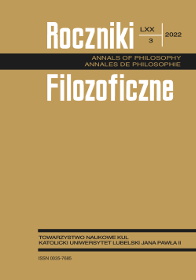Język ruchu Gaga jako wyraz ukrytej dynamiki emocji
Abstrakt
W ramach badań nad emocjami w tańcu naukowcy koncentrują się głównie na ich ruchowej ekspresji. Niniejszy artykuł traktuje o konceptualizacji emocji w specyficznej praktyce ruchu — języku ruchu Gaga, stworzonej przez izraelskiego choreografa Ohada Naharina, która jest oparta na ruchowej interpretacji werbalnych instrukcji podczas improwizacji tanecznej. System werbalnej komunikacji odgrywa istotną rolę w praktyce Gaga. Emocje w ruchowych wskazówkach funkcjonują implicite i są ważnym elementem pracy z ruchem i ciałem tancerzy. Istotne w refleksji o funkcjonowaniu emocji w języku Gaga są rozważania fenomenologiczne Edmunda Husserla oraz Marice’a Merleau-Ponty’ego na temat ciała, które wpłynęły również na współczesną koncepcję poznania ucieleśnionego. Kluczowym w analizie funkcjonowania emocji w języku ruchu Gaga jest zagadnienie dynamiki ujęte z perspektywy fenomenologicznej oraz językoznawczej. Celem niniejszego artykułu jest wykazanie, że: 1) emocje, choć nie pojawiają się bezpośrednio w instrukcjach Gaga, stanowią ważny element pracy twórczej tancerza; 2) ich funkcjonowanie, rozumienie i ruchowa interpretacja opiera się na metaforycznym rozumieniu różnych aspektów dynamiki; 3) dla zrozumienia funkcjonowania emocji podczas tańca istotne są fenomenologiczne analizy ciała.
Bibliografia
Blom, Lynne Anne, i Tarin Chaplin. 1988. The Moment of Movement. Dance Improvisation, Pittsburgh: University of Pittsburgh Press.
Dąbrowski, Andrzej. 2019. Źródła, natura i funkcje emocji. Studium teorii impulsji Leona Petrażyckiego w kontekście współczesnych badań. Warszawa: Wydawnictwa Uniwersytetu Warszawskiego.
Descartes, René. 2004. Medytacje o filozofii pierwszej. Tłum. Jan Hartman, Kraków: Wydawnictwo Zielona Sowa.
Franck, Didier. 2017. Dwa ciała. Wokół fenomenologii Husserla. Tłum. Jacek Migasiński i Anastazja Dwulit. Warszawa: Scholar.
Franklin, Eric. 2007. Świadomość ciała. Wykorzystanie obrazów mentalnych w pedagogice ruchu. Tłum. Zbigniew Zembat. Warszawa: Kined.
Gallagher, Shaun. 2006. How the Body Shapes the Mind. Oxford: Oxford University Press.
Goldstein, Kurt. 1923. „Über die Abhängigkeit der Bewegungen von optischen Vorgängen”. Monatschrift für Psychiatrie und Neurologie 54: 141–194.
Grünbaum, Abraham Anton. 1930. „Aphasie und Motorik”. Zeitschrift für die gesamte Neurologie und Psychiatrie 130: 385–412. DOI: https://doi.org/10.1007/BF02865939.
Heidegger, Martin. 1994. Bycie i czas. Tłum. Bogdan Baran, Warszawa: Wydawnictwo Naukowe PWN.
Husserl, Edmund.1974. Idee czystej fenomenologii i fenomenologicznej filozofii. Tłum. Danuta Gierulanka, tłumaczenie przejrzał i wstępem poprzedził Roman Ingarden. Biblioteka Klasyków Filozofii. Warszawa: Państwowe Wydawnictwo Naukowe [PWN].
Husserl, Edmund. 1982. Medytacje kartezjańskie. Tłum. Andrzej Wajs. Biblioteka Klasyków Filozofii. Warszawa: Państwowe Wydawnictwo Naukowe [PWN].
Ignaczak, Jagoda. „Gaga”. Słownik tańca XX i XXI wieku, http://slowniktanca.uni.lodz.pl/gaga/. Dostęp 26.02.2022.
Johnson, Mark. 1987. The Body in the Mind. The Bodily Basis of Meaning, Imagination and Reason, Chicago, London: University of Chicago Press.
Katan-Schmid, Einav. 2017. „Dancing Metaphors; Creative Thinking within Bodily Movements”. Proceedings of the European Society for Aesthetic 9. Academia.edu, https://www.academia.edu/35842968/Dancing_Metaphors_Creative_Thinking_within_Bodily_Movements_ESA_proceedings_9_2017_. Dostęp 1.03.2022.
Katan-Schmid, Einav. 2018. Embodied philosophy in dance: Gaga and Ohad Naharin’s Movement Research. London: Palgrave Macmillan.
Kövecses, Zoltán. 2000. Metaphor and Emotion. Language, culture, and body in human feeling. Cambridge: Cambridge University Press.
Kövecses, Zoltán. 2014. „Conceptualizing emotions. A revised cognitive linguistic perspective”. Poznan Studies in Contemporary Linguistics, 50, no. 1, https://www.researchgate.net/publication/274208283_Conceptualizing_emotions_A_revised_cognitive_linguistic_perspective. Dostęp 30.02.2022.
Kövecses, Zoltán. 2020. Force dynamics, conceptual metaphor theory, emotion concepts. Budapest: Eötvös Loránd University, https://www.researchgate.net/publication/347437903_Force_ dynamics_conceptual_metaphor_theory_emotion_concepts. Dostęp 20.02.2022.
Lakoff, George, i Mark Johnson. 2010. Metafory w naszym życiu. Tłum. Tomasz P. Krzeszowski, Warszawa: Wydawnictwo Aletheia.
Maciejczak, Marek. 2001. Świat według ciała w ‘Fenomenologii percepcji’ M. Merleau-Ponty’ego. Warszawa: IFiS PAN.
Manning, Erin. 2012. Relationscapes. Movement, Art, Philosophy. Cambridge, MA: MIT Press.
Merleau-Ponty, Maurice. 1999. Proza świata. Eseje o mowie. Tłum. Stanisław Cichowicz, Joanna Skoczylas i Ewa Bieńkowska. Warszawa: Czytelnik.
Merleau-Ponty, Maurice. 2001. Fenomenologia percepcji. Tłum. Małgorzata Kowalska i Jacek Migasiński. Warszawa: Fundacja Aletheia.
Noë, Alva. 2004. Action in perception. Cambridge, MA: MIT Press.
Pokropski Marek. 2012. „Husserl i Henry – spór o intencjonalność.” Przegląd Filozoficzno-Literacki 3 (34): 229–249, https://www.researchgate.net/publication/337029725_Husserl_i_Henry_-_spor_o_intencjonalnosc. Dostęp 2.03.2022.
Pokropski Marek. 2013. Cielesna geneza czasu i przestrzeni. Warszawa: IFiS PAN.
Przybylski, Łukasz. 2015. „Fenomenologiczne źródła problematyki ucieleśnienia”. Poznańskie Studia z Filozofii Nauki 24, nr 1: 51-76.
Talmy, Leonard. 1987. „Force dynamics in language and cognition”. Berkeley Cognitive Science Report no. 12 (1): 49–100.
Zarębska, Paulina. 2019. „Metaforyczność instrukcji choreografa”. Studia Choreologica vol. 20, https://omp.academicon.pl/wa/catalog/view/metafory-ucielesnione/78/212. Dostęp 26.02.2022. DOI: https://doi.org/10.52097/acapress.9788362475810.187-205.
Zarębska, Paulina. 2021. „How do dancers solve their choreographic improvisational problems?” AVANT, 12, no. 2, http://avant.edu.pl/en/2021-01-03-2. Dostęp 1.03.2022. DOI: https://doi.org/10.26913/avant.2021.02.03.
Copyright (c) 2022 Roczniki Filozoficzne

Utwór dostępny jest na licencji Creative Commons Uznanie autorstwa – Użycie niekomercyjne – Bez utworów zależnych 4.0 Międzynarodowe.





